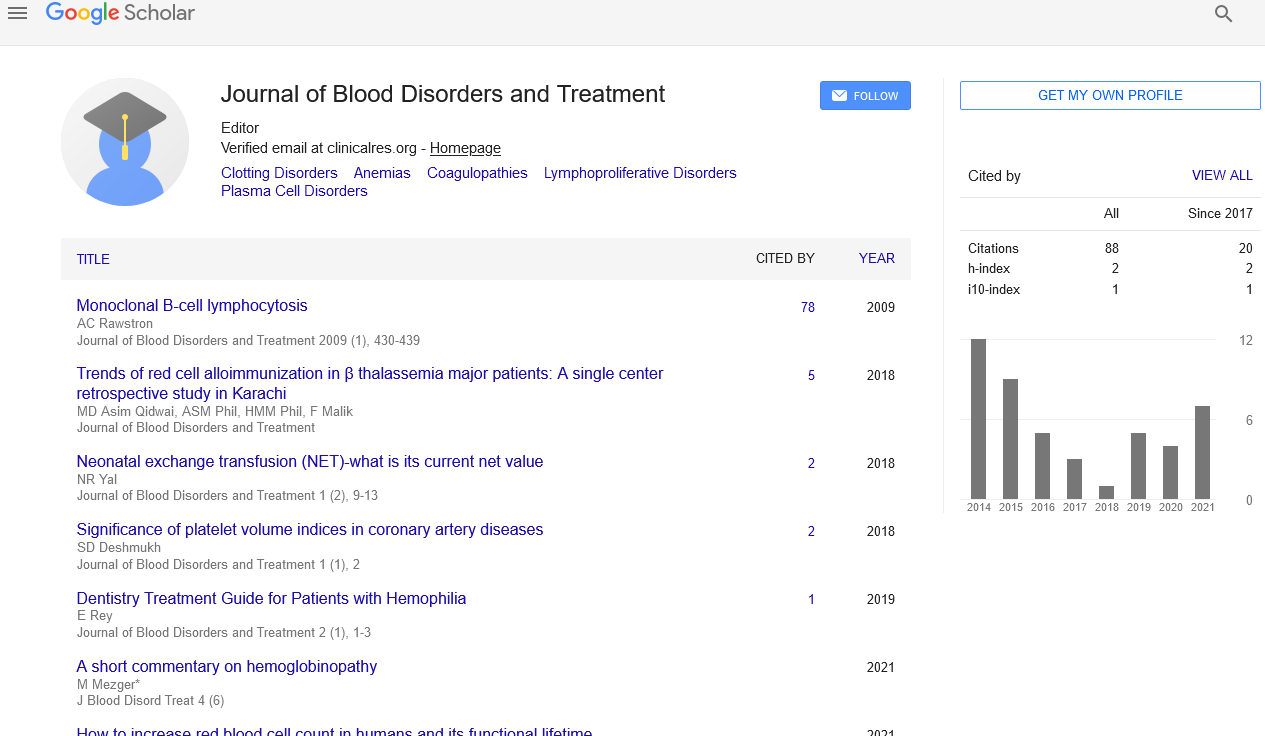Anemia among adolescent females who are attending school in a distant area
Received: 09-May-2022, Manuscript No. PULJBDT-22-5122; Editor assigned: 11-May-2022, Pre QC No. PULJBDT-22-5122 (PQ); Reviewed: 19-May-2022 QC No. PULJBDT-22-5122 (Q); Revised: 21-May-2022, Manuscript No. PULJBDT-22-5122 (R); Published: 29-May-2022, DOI: 10.37532/puljbdt.2022.5(3)26
This open-access article is distributed under the terms of the Creative Commons Attribution Non-Commercial License (CC BY-NC) (http://creativecommons.org/licenses/by-nc/4.0/), which permits reuse, distribution and reproduction of the article, provided that the original work is properly cited and the reuse is restricted to noncommercial purposes. For commercial reuse, contact reprints@pulsus.com
Abstract
A serious health issue affecting adolescent girls is anemia. This study sought to ascertain the prevalence of anemia, its contributing variables, and adolescent girls' understanding of the condition in a rural location. The World Health Organization (WHO) defines adolescence as the time between the ages of 10 years to 19 years old. Because adolescence is a key developmental stage, anaemia at this age can have long-term impacts on d- -evelopment, cognition, immunity, menstrual cycle irregularity, and subsequent poor pregnancy outcomes. Additionally, a higher prevalence of anemia has been connected to several illnesses, including rheumatoid arthritis, congestive heart failure, essential hypertension, hypothyroidism, and hypothyroidism. Most anemiarelated problems can be prevented if mild to severe anemia is treated in its early stages throughout adolescence.
Key Words
Hypothyroidism; Hypertension; Hypoxemia
INTRODUCTION
The most prevalent nutritional deficit in the world, according to the WHO, is Iron Deficiency Anaemia (IDA), which affects 30% of the o- -f the global population. 1 IDA is more common in children and women, but adult men can also be affected, depending on their socioeconomic situation and overall health. Although Gastrointestinal (GI) bleeding and menstruation in women are the most frequent causes of IDA, poor dietary iron intake and absorption are also responsible for the condition.
Numerous cellular processes, such as enzymatic activities, DNA synthesis, oxygen transport, and mitochondrial energy production, all require iron. As a result, there is a wide variety in the symptoms of IDA. Reduced blood oxygen levels can cause shortness of breath, tiredness, palpitations, tachycardia and angina. The ensuing compensatory decrease in intestinal blood flow brought on by the resulting hypoxemia may result in motility problems, malabsorption, nausea, weight loss and abdominal pain. Numerous studies have shown that cognitive skills improve as anaemia returns to normal in patients with central hypoxia, who may also have headaches, vertigo, lethargy, and cognitive impairment. It is widely acknowledged that IDA hurts the Quality Of Life (QoL), with current research showing that treating IDA enhances the quality of life independent of the underlying condition.
A vital element, iron is primarily regulated by food, intestinal absorption, and iron recycling. Haem and non-haem iron are the two types of dietary iron. Haem iron is easily absorbed and is found in animal meat, poultry, and fish in the form of myoglobin and Haemoglobin (Hb). Although largely contained in plant food, non-haem iron is less readily absorbed. Plant-derived substances like phytate, oxalate, polyphenols and tannin, as well as some medications like proton pump inhibitors, reduce the absorption of non-haem iron. Anemia is defined by the WHO as having a blood Hb level below 120 µg/L for women and 130 µg/L for males. Serum ferritin, which serves as an iron storage molecule, should be less than 30 µg/L in cases of isolated iron shortage.
But because ferritin is an acute-phase protein, it might rise when there is inflammation. Therefore, a ferritin level of less than 100 µg/L is suggestive of IDA if there is evidence of concurrent inflammation, such as increased C reactive protein. The iron transporter transferrin is normally raised, but because it is a protein in the negative acute phase, it can also be normal or lowered under conditions of chronic inflammation. TSATs for serum iron and transferrin will decrease, with a TSAT of less than 20% being necessary for the diagnosis of IDA.
In a recent study, alternate-day, divided-daily, and once-daily oral iron dose regimens were compared in women with moderate anemia. The results showed that alternate day dosing was preferable, with 33% greater fractional iron absorption throughout 14 doses. In addition, senior IDA patients in a randomized experiment received daily doses of 15 mg, 50 mg, or 150 mg of elemental iron. The mean Hb increase after two months was the same in all groups (1.4 g/dL), although side effects were noticeably worse with higher dosages. A single daily dose (40 mg to 60 mg) or a slightly greater alternateday dose (80 mg to 100 mg) is, therefore, the optimal dosing regimen to minimize adverse effects and maximize the quantity of elemental iron, according to an emerging theory.





